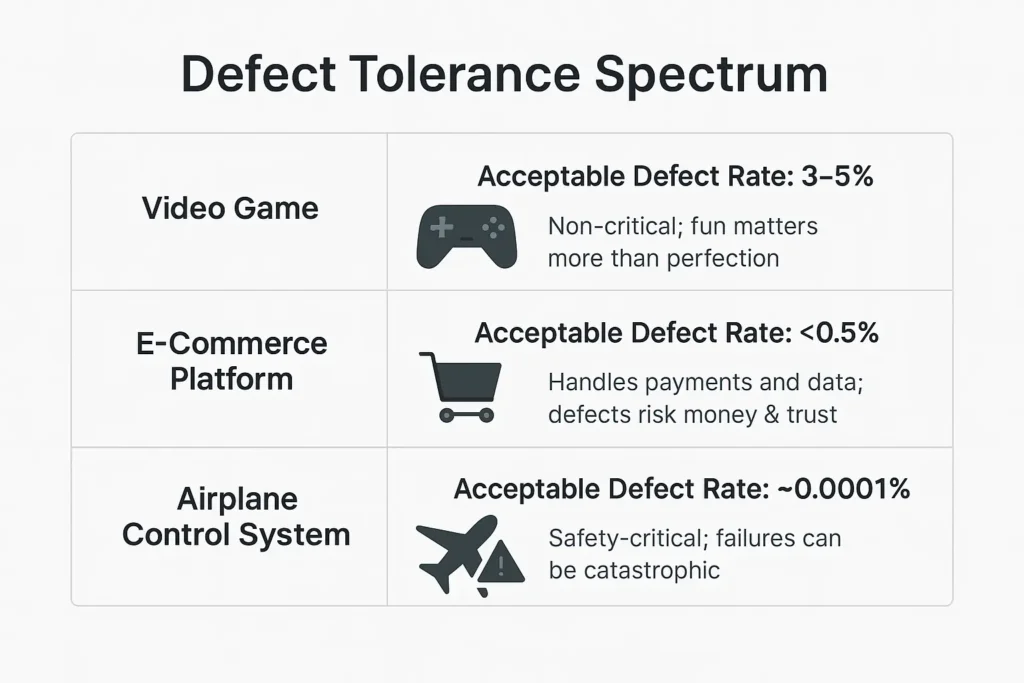 Back to all articles
Back to all articles
Blogs
The Role of Software Testing in Quality Assurance


Imagine buying a fruit; you can immediately check its quality, including its size, shape, ripeness, and any marks on it. But then you take only one bite, you will understand whether this fruit is good or bad.
This same thing applies to any product, whether it's physical or digital. A website looks fine at first sight, but as you scroll down, go to a different page, and interact with it, you will identify the issues in that site. Poor quality software leads to a lot of problems, which can be challenging for end users and can cost too much for software owners.
Core Elements of Software Testing
Goal
The basic aim of software testing is to detect any defects or issues in the software in order to maintain the quality of the product.
Scope
Testing of software is solely focused on the functionality of the software and finding the defects in it.
Involvement
Software tester teams are very actively involved in the testing process, like reporting bugs, executing tests, and verifying the resolution of bugs or issues.
Methods
The software testing usually consists of the usage of automation tools or manual testing.
Duties
It is the duty of software testers to ensure that the software fulfills all the standards of quality and requirements that are provided by customers.
Deliverables
The deliverable is simply a report of software testing, which includes a list of bugs or issues, a test summary, and more recommendations for improvements.
QA vs QC and Testing Comparison
| Aspect | Quality Assurance (QA) | Quality Control (QC) | Testing |
| Purpose | Prevent defects by defining quality standards and improving processes. | Ensure the final product meets defined requirements. | Identify, isolate, and fix defects in the product. |
| Focus | Development processes and workflows. | The completed product as a whole. | Specific elements of the product: functionality, performance, security, etc. |
| Who | External stakeholders, business analysts, QA engineers, and developers. | QA engineers, developers. | QA engineers, developers. |
| When | Continuously, throughout the entire development lifecycle. | Primarily, before product release. | During dedicated test phases and throughout development. |
| Activities | Define standards, create best practices, set guidelines, and refine processes. | Inspect and validate the product against the acceptance criteria. | Review code, execute tests, report bugs, and verify fixes. |
Software testing principles
There are seven principles of software testing that act as fundamental guidelines for the testing process.
Testing to Identify Mistakes
The aim of testing is to identify bugs or issues with the software. But here is the fact that no matter how hard you try, you can never be one hundred percent sure that there are no bugs left. Testing can only decrease the number of issues hidden in the project.
Exhaustive Testing
It is nearly impossible for a tester to test every possible combination of data scenarios, inputs, and preconditionings in an app. Let's assume that a single screen contains 10 input fields, each with three possible value options, then the tester needs to make 59049 (310) scenarios to complete all the combinations. You need to keep your focus more on common scenarios in order to avoid spending weeks.
Early Testing
As you know, the cost of mistakes grows with each phase of the software development cycle. So it is essential to test the code from the start, as soon as possible, to solve the bugs and not let them collect in the end.
Defect Clustering
Defect clustering, which is often defined as the Pareto principle in software testing, suggests that around 80%of defects are usually found in 20% of system modules. If you found an issue in one component so there is a higher chance of finding bugs in other components too. So it's important to do testing with full focus and thoroughness of a product.
Pesticide paradox
If you are doing the same tests repeatedly, it isn't going to help you find more issues. When you resolve the identified issues, the last scenarios are totally useless to you.
Testing is context-dependent
According to the goal or industry type, there are different types of testing applications available. Like any tech product, this product demands more security and importance compared to other corporate websites, focusing on speed and usability.
Zero Error Myth
No error doesn’t guarantee that your product will be successful. It doesn't matter how much time and resources you spend on testing or polishing the code; if it doesn't meet user expectations, then it's just a waste of time and cost.
Defect Tolerance Spectrum

| Software Type | Acceptable Defect Rate | Reason |
| Video Game | 3–5% (minor glitches) | Non-critical; fun matters more than perfection |
| E-Commerce Platform | <0.5% | Handles payments/data; defects, risk, money & trust |
| Airplane Control System | ~0.0001% | Safety-critical; failures can be catastrophic |
Advantages of Software Testing
Quality Enhance
Software testing can help you to enhance the quality of software by simply identifying bugs in the software and fixing the problem before it is given to users. It helps to make a better user experience and increase customer satisfaction.
Early Detection
Software testing helps in the detection of problems earlier in the development phase, which is far easier to fix bugs front he release of software. This helps in cost reduction of development and time as compared to the market.
Cost Saving
Software testing allows you to recognize the issues in the software and also helps you decrease the cost of development by ensuring that the software is released without any major issues. It helps in the long term for saving the development cost as well as the maintenance cost.
Better User Experience
Software testing allows you to ensure that the user experience is fully optimized, which ultimately makes the product more attractive to users. It also leads to an increase in sales due to improved customer satisfaction and loyalty.
Limitations of Software Testing
Time
Software testing takes too much time to complete for a single project. According to the complexity of the project, no of tests that need to be performed can take days or sometimes weeks.
Scope
Software testing is always limited in scope; it cannot do the entire system’s testing, but only the software that is being tested. Which can definitely cause problems if the other parts of the system are not tested properly.
Assumption
Software testing is totally based on assumptions; if the assumptions are wrong, your software might not work properly.
Complexity
Software testing is very time-consuming and complex, but it also leads to a slow development process and can be costly sometimes.
Conclusion
Software testing is more than finding bugs; it's about ensuring a product meets user needs and business goals. While QA sets standards to prevent defects, testing uncovers faults before they reach customers, as shown in the SQA process. Despite its limits, testing improves quality, reduces costs, and delivers a better user experience. But remember: a bug-free product isn’t always a successful one; true quality comes from meeting real user expectations.
Don't hire us right away
talk to our experts first,
Share your challenges, & then decide if we're the right fit for you! Talk to Us
Partnerships & Recognition
Commitment to excellence






